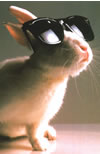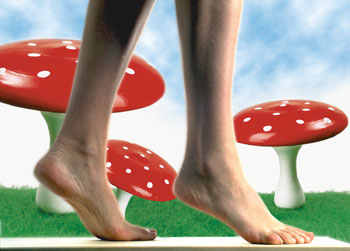

GD — Society for Dermopharmacy
 |
Issue 1 (2003) |
Dermatotherapy
Treatment of Mycosis Pedis by Means of Topical
Antimycotics:
The Basis is Likewise Important For a Successful Therapy
There is obviously a much higher incidence of mycoses pedis than presumed
to date. A great European study, the so-called Achill-Project revealed that
there are indications for the presence of foot and/or nail mycoses at every
third person. Mycoses pedis thus belong to the numerically most significant
infectual diseases. For the treatment mainly topical antimycotics on the
basis of very differing active ingredients and presentation forms are used.
Professor Dr. med. Christian Korting, Munich, explained in a conversation
with DermoTopics which criteria are to be considered when selecting and
applying topical antimycotics. Korting is vice-president of the GD - Society
for Dermopharmacy and secretary of the German Mycological Society.

DermoTopics:
Professor Korting, why are mycoses pedis to be taken seriously and treated
as early as possible?

Prof.
Dr. med. Hans Christian Korting
Professor Korting:
Above all mycoses pedis are to be taken seriously because, as we know today,
they are able to entail serious secondary diseases. If for example a dermatophyte
infection in the interdigits, which seems to be insignificant, is not treated,
it can easily spread to the entire forefoot and also seize the nail region,
i. e. trigger an onychomycosis. The latter again is able to cause major
complaints and consequently a considerable impairment of the quality of
life. Moreover, foot mycoses are linked to a disturbance of the epidermal
barrier. As a consequence, additional pathogens can penetrate skin more
easily and produce independent infections. We were able to show in a case-control
study in the course of a dermatological world congress in Paris last year
that foot mycoses contribute to the generation of the erysipelas at the
lower leg. This dermatosis is in most cases due to a streptococcus infection,
which is normally linked to considerable impairment, e.g. high fever and
does not seldom involve the necessity of a stationary treatment causing
not least considerable costs.
DermoTopics:
Can the reason for the high incidence of mycoses pedis be attributed to
insufficient therapeutical treatment methods?
Professor Korting:
Here is a differentiation necessary. Dermatophyte infections at the free
part of the foot are normally treated topically and for the topical treatment
there are numerous antimycotics with high efficiency available today. Problematic
is however that many antimycotics have to be applied for several weeks over
the stage of the subjectively perceived symptoms. This may lead to treatment
failures due to non-compliance by patients. As the symptoms itching and
reddening may generally ease after only few treatment days, numerous patients
terminate the therapy too early. This behavior reduces the healing prospects
and the risk of recurrence increases.
DermoTopics:
Your expositions concerning the necessity of a several-week therapy duration
regard above all azole derivatives. For topical Terbinafine (Lamisil®)
in contrast, an application duration of only seven days is claimed. Is such
a short treatment time really sufficient for a safe treatment of mycoses
pedis?

Widespread disease mycosis pedis: approximately one third of the population
is affected by this dermatosis.
Professor
Korting:
In fact topical Terbinafine has to be applied only once a day on seven days
running if the toe interdigits are seized. This short-term therapy favorable
for compliance has been proven for the three presentation forms terbinafine
cream, dermGel and -spray available in the market in controlled clinical
studies and also recognized by the authorities. Moreover, comparative clinical
studies have shown that the one-week short-term therapy with Terbinafine
leads to a higher or at least equally high healing rate as well as less
relapse and re-infections than a four-week therapy based on the topical
Clotrimazole.
DermoTopics:
Does the short-term therapy based on topical Terbinafine also have cost
benefits compared with a several week therapy by means of other antimycotics?
Professor
Korting:
If one considers - as is often done in superficial cost comparisons, only
the prices relating to the gram of preparation of the corresponding products,
then the impression is generated that in particular many azole-containing
antimycotics are more cost-effective than topical Terbinafine. The price
advantage of azoles is however compensated by the required high application
frequency over several weeks and the relatively high product consumption
caused by this fact. This is why an advantageous calculation can be made
for topical Terbinafine as regards the procurement costs in spite of the
still existing patent protection even compared with the, related to the
unit weight, relatively low-priced azole-containing generics.
DermoTopics:
Critics maintain that the short-term therapy based on topical Terbinafine
is not sufficient to regenerate the skin barrier impaired by the dermatophyte
infection. Is for that reason an antimycotic therapy yet more recommendable
than a short-term therapy?
Professor
Korting:
The decisive fact is that the infected skin areas are clinically and mycologically
healed at the termination of the therapy. If the infection and thus the
cause of the barrier impairment are eliminated the epidermis swiftly regains
its integrity protecting from recurrence and re-infections. An extension
of the therapy beyond the stage of mycological healing has if at all an
additional cosmetical benefit in the sense that the skin caring properties
of the preparation base accelerates the restitution of the barrier. To date
however, it has not been investigated whether or not the benefit of such
a care effect is higher at a several-week therapy than at the one-week short-term
therapy.
DermoTopics:
You are addressing the bases of topical antimycotics. In which way do they
influence the therapy results?
Professor
Korting:
As in the topical Dermatotherapy in general, the base of the product for
external application used in the treatment of the mycosis pedis may influence
the overall effect of the product. This for example was the result of placebo-controlled
clinical studies with the Terbinafine cream available in the market. In
these studies besides curing rates of 88 respectively 91 per cent for the
active agent-containing cream and a relatively high mycological curing rate
of 23 respectively 37 percent of the active agent-free base after only one
week of application could be proven. The skin caring properties of the cream
base are able to explain this surprising result. The care effect of the
base is here obviously so significant that it promotes the healing of the
dermatophyte infection in spite of an application of merely one week.
DermoTopics:
In which cases should a topical treatment of mycoses pedis with creams be
applied and when are other presentation forms appropriate?
Professor
Korting:
Due to their additionally expected care effect creams are recommended in
particular with scaling forms of mycoses pedis, which are not connected
with strong itching. If however, strong itching appears, the application
of cooling gels is recommended. Beneficial are especially emulsion gels
(for example Lamisil® DermGel®), which have both a cooling and care
effect and thus combine the properties of a gel and a cream. Alcohol-containing
gel bases should however, equally as alcoholic solutions only be applied
in limited uses with severe skin lesions. The advantage of spray solutions
is easy and comfortable application as well as the possibility to use the
product without applying the fingers and also at limited bodily flexibility.
DermoTopics:
Professor Korting, thank you for the conversation (jk).
top